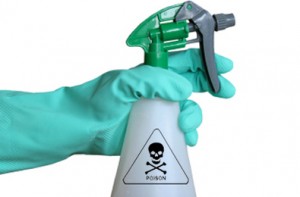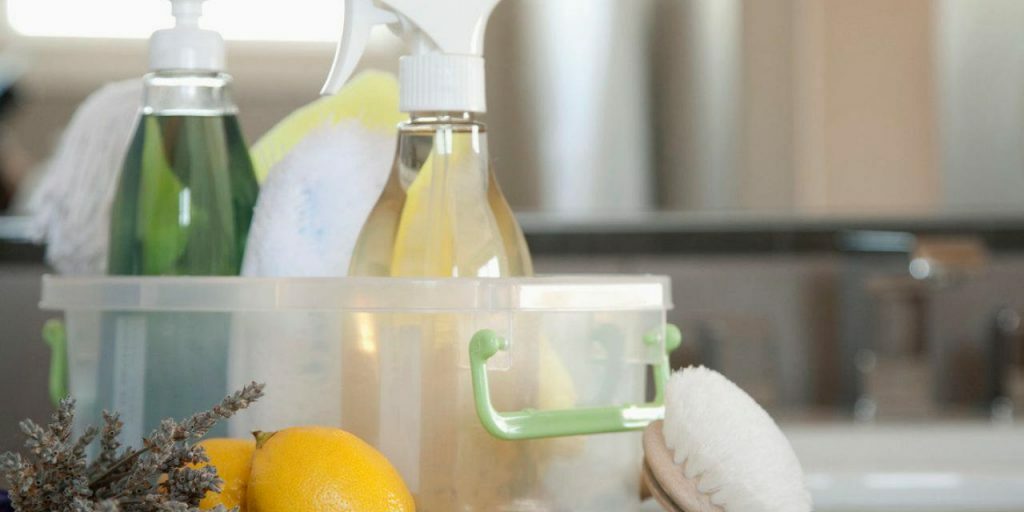 I love Spring Cleaning. I like to set aside a whole morning to really get stuck into it, however, you know me – it’s got to be 100% non-toxic. There is absolutely no way that I’m going to put myself or my family at risk of breathing in toxic fumes, and trust me – most commercial cleaning products are full of them. Examples of some of these chemicals include: Ammonia, Formaldehyde, Phthalates, Benzalkonium Chlorid, and 2-butoxyethanol. It is vital that parents of babies/small children take heed of the fact that indoor air quality can be up to 10 times worse than outdoor air quality, and part of the reason is that we clean our homes a cocktail of really toxic ingredients. According to the Consumer Product Safety Commission, 150 chemicals most commonly found in homes have been linked to allergies, birth defects, cancer and psychological abnormalities. Some cleaners are worse than others, but at the very least, switch out the following 5 products.
I love Spring Cleaning. I like to set aside a whole morning to really get stuck into it, however, you know me – it’s got to be 100% non-toxic. There is absolutely no way that I’m going to put myself or my family at risk of breathing in toxic fumes, and trust me – most commercial cleaning products are full of them. Examples of some of these chemicals include: Ammonia, Formaldehyde, Phthalates, Benzalkonium Chlorid, and 2-butoxyethanol. It is vital that parents of babies/small children take heed of the fact that indoor air quality can be up to 10 times worse than outdoor air quality, and part of the reason is that we clean our homes a cocktail of really toxic ingredients. According to the Consumer Product Safety Commission, 150 chemicals most commonly found in homes have been linked to allergies, birth defects, cancer and psychological abnormalities. Some cleaners are worse than others, but at the very least, switch out the following 5 products.
1. Counter and all-purpose sprays that contain bleach (and bleach itself): The Sodium Hypochlorite in the bleach can cause serious irritation to your respiratory system and skin. Repeated use can cause permanent respiratory damage. Also, never mix bleach with Amonia or any drain cleaner because it can produce deadly fumes.
2. Oven Cleaner: Your average oven-cleaner is super duper toxic. It includes ingredients that are extremely corrosive – so much so that they can burn your skin, and harm your respiratory system when inhaled. These chemicals can be deadly if swallowed. I clean my oven by making a paste of baking soda, table salt and water.
3. Window and Glass Cleaners: These seemingly innocent-looking sprays also contain a cocktail of toxic ingredients. Moreover, they are expensive, and given the fact that white vinegar, warm water, and a little dish soap does as good a job – make the switch!
4. Sudsy/Foaming Bathroom cleaners or Bathroom Sprays: Some of these cleaners contain the sudsing agents diethanolamine (DEA) and triethanolamine (TEA). When these substances come into contact with nitrites, often present as undisclosed preservatives or contaminants, they react to form nitrosamines – carcinogens that can penetrate the skin. 1,4-dioxane, another suspected carcinogen, may be present in cleaners made with ethoxylated alcohols. Butyl cellosolve is another ingredient that may be found in these kind of cleaners and it could be neurotoxic (cause damage to the brain and nervous system).
5. Drain Cleaners: These can be so very toxic that I’m horrified they are still legal to sell. Aside from the toxic element, they can easily corrode your plumbing pipes, and should never be used. I always use Earth’s Enzymes instead. These natural enzymes take longer to work and may not un-clog a badly clogged drain (call out the plumber if this is the case – better than pouring gallons of toxic liquid down there). I use the enzymes each week to gently break up grease and deposits – it’s more of a maintenance measure, which will help to keep your drains in good working condition.
The great news is that there are now a number of safer/greener cleaning products on the market – and many of them smell amazing and do a great job. One of my favorite brands is Ecos because they are about the greenest company in the U.S. They are also priced really well. However, if you want to save even more pennies, it’s ridiculously easy to make your own.
Here are 3 of my favorite Green-cleaning DIY recipes:
All-purpose Cleaner
This works for counter tops, tables, cabinets, fridge interior, sink, and can even work on kitchen floors (not wood). It’s a great alternative to the bleach sprays.
You will need:
1 24-oz sprayer
1tsp borax
1/2 tsp washing soda crystals
2tbsp white vinegar
1/2 tsp liquid castille soap
2 cups hot water
20 drops of tea tree or lavender essential oil
Mix the borax, washing soda, vinegar and castile soap on a large measuring cup. Slowly add the hot water (just off the boil). Allow it to cool before adding the tea tree oil. Pour into the sprayer. Shake well before each use.
Green Scouring Tile/Grout Cleaner
This is better than any of the brand-name scouring powders, and sudsy bathroom cleaners, and costs just pennies to make.
1 cup baking soda
2/3 cup Liquid Castille Soap
20 drops of whichever essential oil you love
Large container with a lid (I use a glass Pyrex storage container).
Place all the ingredients except the water in your container. Mix to a thick paste. You may need more or When ready to use, scoop out a glob of the paste with a scouring sponge or a natural bristle brush.
DIY Toilet Cleaner
This toilet cleaner will make your toilet smell great, too.
1 cup borax
1 cup white vinegar
10 drops lavender essential oil
10 drops lemon essential oil
You can use a squirt bottle, or an old toilet cleaner bottle (washed out). Simple mix the ingredients in a measuring cup and pour into your bottle.
Spring Cleaning Tips:
1. As soon as the sun comes out, take your pillows and comforters outside, give them a really good shake/beat, and drape them over a drying line, or hedge in your backyard. The sun helps to freshen your bedding.
2. Fill a sprayer with equal parts of white vinegar and distilled water, and spritz all of those bathroom nooks and crannies in which mold/mildew tends to grow.
3. Unscrew your shower head and soak in a bowl of neat white vinegar for a couple of hours. This will loosen lime buildup. Follow by scrubbing it with a hard bristle brush. 4. Having wiped out your fridge with my all-purpose cleaning spray (above), Spritz all the nooks and crannies with a sprayer filled with equal parts distilled water and food grade (from drug store) hydrogen peroxide. This will help to kill any lurking bacteria.




Pingback: Green Spring cleaning | The Cultural & Econ...